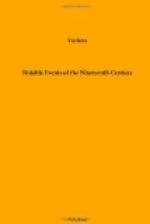A considerable space about the centre of the planetary zone between Mars and Jupiter is occupied with these multitudinous pigmy worlds that follow the one the other in endless flight around the sun. It is a sort of planetary shower; and it can hardly be doubted that the bodies constituting the flight are graded down in size from larger to smaller and still smaller until the fragments are mere blocks and bits of world-dust floating in space. Possibly there may be enough of such matter to constitute a sort of planetary band that may illumine a little (as seen from a distance) the zone where it circulates.
As to the origin of this seemingly fragmentary matter, we know nothing, and conjectures are of little use in scientific exposition. It may be true that a large planet once occupied the asteroidal space, and that the same has been rent by some violence into thousands of fragments. It may be observed that the period of rotation of the inferior planets corresponds in general with that of our earth, while the corresponding period of the superior or outside planets is less than one-half as great. The forces which produced this difference in the period of rotation may have contended for the mastery in that part of our solar system where the asteroids are found; and the disruption may have resulted from such conflict of forces.
Or again, it may be that a large planet is now in process of formation in the asteroidal space. Possibly one of the greater fragments may gain in mass by attracting to itself the nearer fragments, and thus continue to wax until it shall have swept clean the whole pathway of the planetary matter, except such small fragments as may after aeons of time continue to fall upon the master body, as our meteorites now at intervals rush into our atmosphere and sometimes reach the earth.
Some astronomers have given and are still giving their almost undivided attention to asteroidal investigation. The discoveries have been mostly made by a few principal explorers. The astronomer, Palisa, from the observatory of Pola and that of Vienna, has found no fewer than seventy-five of the whole group. The observer, Peters, at Clinton, New York, has found forty-eight asteroids; Luther, of Duesseldorf, twenty-four; Watson, of Ann Arbor, twenty-two; Borrelly, of Marseilles, fifteen; Goldschmidt, of Paris, fourteen, and Charlois, of Nice, fourteen. The English astronomers have found only a few. Among such, Hind of London, who has-discovered ten asteroids, is the leader.
The Italian, German and American astronomers are first in the interest and success which they have shown in this branch of sky-lore. Their investigations have made us acquainted with the dim group of little worlds performing their unknown part in the vast space between the Warrior planet and Jove.




